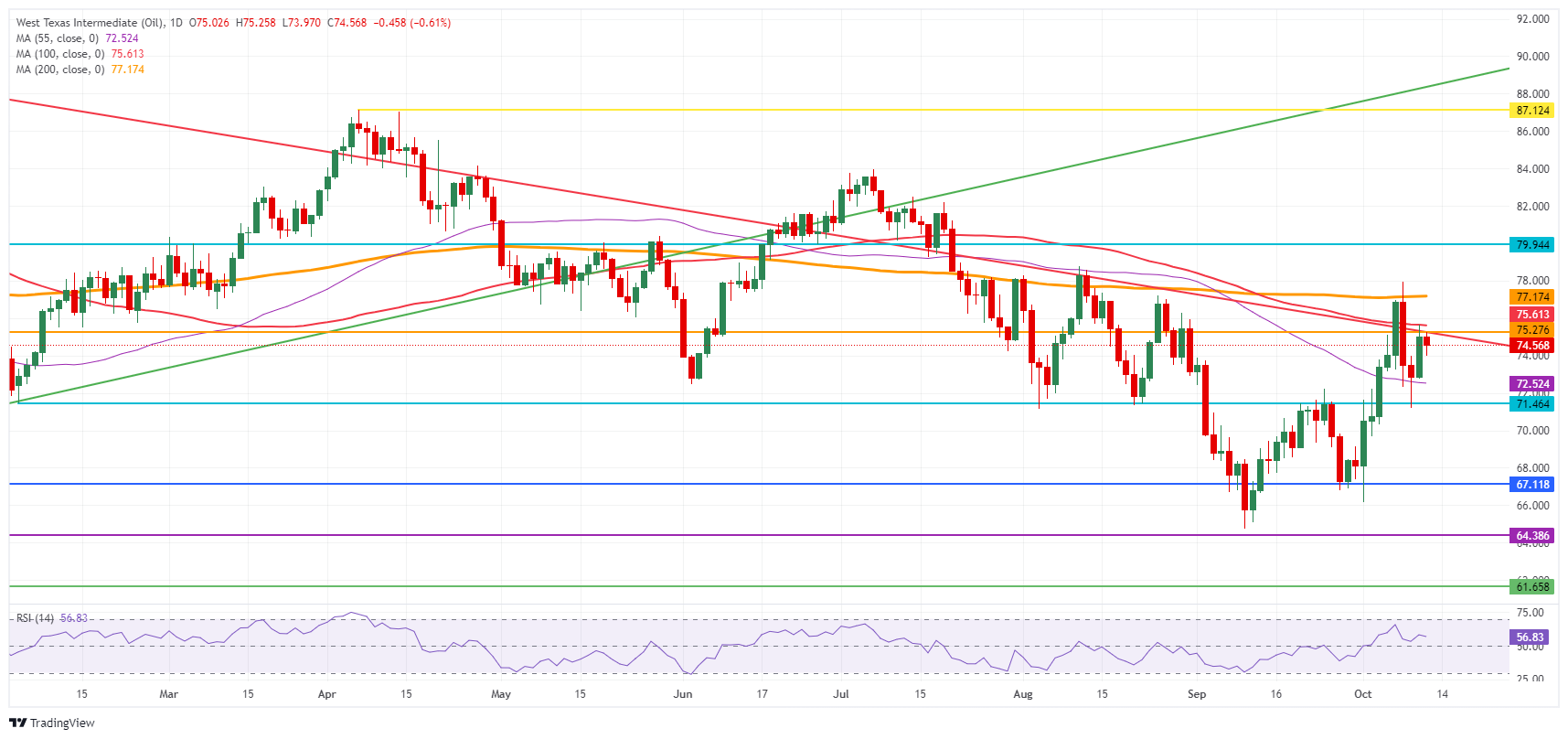- After a volatile week, crude oil stabilizes near $75 on Friday.
- Israel has signaled it is ready to retaliate against Iran’s attacks, raising tensions and supporting crude oil prices.
- The US Dollar Index halts its rally after reaching its highest level in almost two months.
Crude oil is back to square one this week, stabilizing around Monday’s opening price near $75.00. The recovery from the lowest levels seen earlier this week comes after Israel signaled it is ready to retaliate against Iran. The headline comes after United States (US) President Joe Biden had a phone call with Israel’s Prime Minister Benjamin Netanyahu on Wednesday, with President Biden urging not to attack Iranian oil facilities . Meanwhile, Florida is assessing damage from Hurricane Milton, and oil platforms in the U.S. Gulf of Mexico are preparing to reopen again.
The US Dollar Index (DXY), which tracks the performance of the dollar against six other currencies, retreats slightly on Friday after its small rebound on Thursday, when the US Consumer Price Index (CPI) was released. by September it caused the DXY to reach a peak of 103.18. Unfortunately, it encountered resistance and saw some profit taking entering Friday.
At the time of writing, Crude Oil (WTI) is trading at $74.73 and Brent Crude at $78.55.
Oil news and market movements: Intense weekend
- The Washington Post reports that Israel’s war cabinet will meet this Friday to decide how it will retaliate. The Cabinet meeting follows Wednesday’s 30-minute phone call between US President Biden and Israeli Prime Minister Netanyahu to consider the response.
- The price of US shale is being estimated at around $66 per barrel, according to Bloomberg. This means that at current prices, the US will continue to increase its shale production to supply enough oil to the markets and keep oil prices in check.
- At 17:00 GMT, the Baker Hughes oil rig count will be published. The previous reading was 479 platforms, with no forecast available.
Oil technical analysis: Weekend full of events
Crude oil is headed for an eventful weekend, with Israel signaling it is ready to retaliate against Iran. Therefore, traders can expect plenty of headlines over the weekend regarding geopolitics in the Middle East. And as if that weren’t enough, the Chinese government is set to announce possibly more stimulus measures, the impact of which will only be seen on Monday when the markets open.
Monday’s false breakout should be ignored, as the move was completely reversed on Tuesday. This means that the current crucial upside levels remain valid: the red descending trend line on the chart below, and the 100-day SMA at $75.61 just above it, make that region is very difficult to overcome. Once it holds above that zone, the 200-day SMA at $77.17 should refute any further rally, as it did in early trading on Tuesday.
On the downside, there is a similar observation as on the upside with this false breakout. The general rule is that if there has been no daily close below the level, it still acts as support. First is the 55-day SMA at $72.52, which acts as a potential first line of defense. A little further down, $71.46 (Feb 5 low) comes into play as second support before looking back at the big $70.00 and $67.11 as final support for traders to buy. in the fall.
US WTI Crude Oil: Daily Chart
WTI Oil FAQs
WTI oil is a type of crude oil that is sold in international markets. WTI stands for West Texas Intermediate, one of the three main types that include Brent and Dubai crude. WTI is also known as “light” and “sweet” for its relatively low gravity and sulfur content, respectively. It is considered a high-quality oil that is easily refined. It is sourced in the United States and distributed through the Cushing facility, considered “the pipeline junction of the world.” It is a benchmark for the oil market and the price of WTI is frequently quoted in the media.
Like all assets, supply and demand are the main factors that determine the price of WTI oil. As such, global growth can be a driver of increased demand and vice versa in the case of weak global growth. Political instability, wars and sanctions can alter supply and impact prices. The decisions of OPEC, a group of large oil-producing countries, is another key price factor. The value of the US Dollar influences the price of WTI crude oil, as oil is primarily traded in US dollars, so a weaker Dollar can make oil more affordable and vice versa.
Weekly oil inventory reports published by the American Petroleum Institute (API) and the Energy Information Agency (EIA) influence the price of WTI oil. Changes in inventories reflect the fluctuation of supply and demand. If the data shows a decline in inventories, it may indicate an increase in demand, which would drive up the price of oil. An increase in inventories can reflect an increase in supply, which drives down prices. The API report is published every Tuesday and the EIA report the next day. Their results are usually similar, with a difference of 1% between them 75% of the time. EIA data is considered more reliable since it is a government agency.
OPEC (Organization of the Petroleum Exporting Countries) is a group of 13 oil-producing nations that collectively decide member countries’ production quotas at biannual meetings. Their decisions often influence WTI oil prices. When OPEC decides to reduce quotas, it can restrict supply and drive up oil prices. When OPEC increases production, the opposite effect occurs. OPEC+ is an expanded group that includes ten other non-OPEC member countries, including Russia.
Source: Fx Street
I am Joshua Winder, a senior-level journalist and editor at World Stock Market. I specialize in covering news related to the stock market and economic trends. With more than 8 years of experience in this field, I have become an expert in financial reporting.








